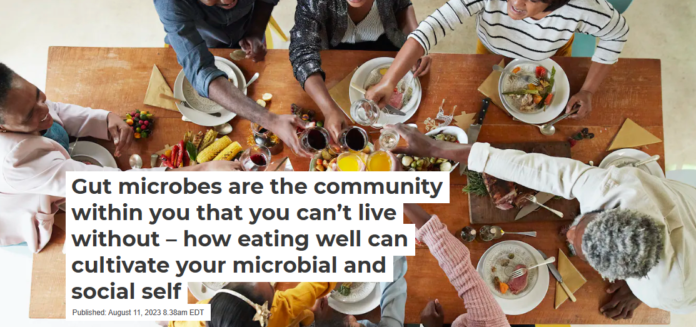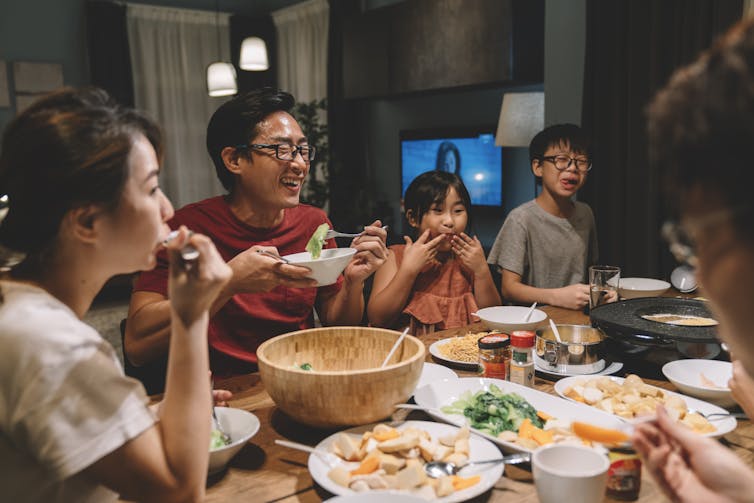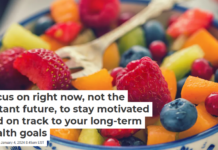

Christopher Damman, University of Washington
The age-old adage “you are what you eat” holds profound truth. Nearly every molecule in your body is absorbed from what you eat and drink. Your food choices are directly linked to your physical, emotional and social health. And scientists are learning that your gut health and the microbial communities within you have a significant role to play in orchestrating these processes.
The gut microbiome takes the components of food that you cannot digest, like fiber and phytonutrients, and transforms them into signals that regulate how hungry you are, how strong your immune system is, and even how you’re thinking and feeling. It’s as though the communities in your gut microbiome are an orchestra for your health, and you conduct their symphony through food.
I am a gastroenterologist who has spent over 20 years studying how food affects the gut microbiome and overall health. The research is increasingly clear: A gut-friendly approach to nutrition is important for happy and healthy communities both inside and out of your body.
Communities within and without
The fascinating research on the gut microbiome takes us on a journey into the depths of the intestine, where trillions of microorganisms blur the lines between other and self.
The term holobiont describes the combined lives of the microbiome and its vessel, working symbiotically to support each other’s well-being. This relationship is represented at its extreme in the intestines of termites and cows, where microbes transform uniform, low-nutrient diets of wood or grass into complete nutrition replete with vitamins and other essential nutrients for health.
When people eat certain foods, like those rich in fiber, they too harbor similar relationships with their microbiomes. You provide your microbes with food and a safe place to live, and they in turn fortify your diet with vital molecules such as vitamins, short-chain fatty acids and neurotransmitters that are key for regulating your metabolism, immunity and mood.

Just as food illuminates the importance of the microbial community within you, it also shines a light on your social community. Food is one of the foundations of culture, serving as the basis of many gifts and shared experiences. You have first dates over drinks and meals, connect with your colleagues over lunch, and share dinners with your family and friends. Food is a type of social glue that helps bind communities together.
As you feed your microbiome to cultivate a thriving community within your gut, you also figuratively and literally feed your social community when you break bread with friends and family.
Convenient fixes sacrifice community
Convenient, fast, affordable ultraprocessed foods have some enormous benefits in helping feed a growing population and enabling an ever-quickening pace of life, but the latest research is showing that there may be collateral damage.
Compared with ancestral diets, industrialized diets may be contributing to less diverse microbial communities in your gut. Diversity is important for generating key molecules like butyrate that regulate appetite and mood. As a result, your microbiome becomes less good at regulating hunger and emotions.
Your social community may also be suffering as result of this disrupted microbial community. In fact, studies on various model organisms have found that microbes can mediate behaviors as diverse as mating and aggression by regulating responses to stress. Food and microbes may affect social behavior in people as well.
Processed foods do serve a purpose. They are convenient and affordable and can be especially useful for people and families with busy lives and limited time to cook. But some are healthier than others. Adding back missing nutrients like fiber and polyphenols to processed foods can help make them healthier, and these can complement a diet of less-processed foods.
Wisdom cultures around the world
Anthropological research suggests that traditional diets are a particularly important contributor to health and longevity. Communities in Costa Rica, the Mediterranean and Japan that follow traditional diets have many individuals who live for over 100 years. The Mediterranean and Okinawan diets have consistently been shown to contribute to better health, including lower rates of obesity and other metabolic diseases.
These diets involve traditional food choices and combinations as well as natural food processing and preservation techniques. Combining corn with lime, an ancient process called nixtamalixation, for example, increases vitamin availability and decreases grain toxins. https://www.youtube.com/embed/_LKe9hmXdvM?wmode=transparent&start=0 Nixtamalization is used to make traditional tortillas.
Fermentation transforms food through live microbes that consume simple carbohydrates, generating antimicrobial chemicals that help preserve food. It also decreases toxins and increases the levels of vitamins and minerals available for absorption. Fermented foods have been shown to grow diverse microbial communities in the gut, decrease inflammation in the body and reduce the risk of chronic disease.
Communal eating is also intricately woven into the social fabric of traditional communities. The longest-lived communities around the world tend to eat at least one of their meals together as a family, and eating together is linked to health benefits including weight regulation and lower depressive symptoms.
Reembracing community
Here are a few simple tips to help you eat well and grow your communities – holobiont, family, friends and all:
- Eat the four phonetic food F’s: fiber, phytonutrients, healthy fats and ferments. I developed this simple way of categorizing foods to streamline the often complicated advice on how to eat well from the perspective of growing a healthy microbiome. It is also independent of cultural background, as these four categories are common elements in the diets of diverse and long-lived populations around the world.
- Learn the wisdom of traditional food preparation from people who still hold that knowledge. Consider taking a cooking class or spending time in the kitchen learning from a relative or a friend. Then re-share what you learn with your loved ones while preparing and enjoying your own meals.
- You don’t have to be perfect. Even a step toward a healthier meal a day and a communal meal a week can be beneficial.
It may at first seem daunting to carve out time to follow these deceivingly simple tips. But with a bit of patience and perseverance, they could be inspiration to improve your and your community’s health and wellness.
Christopher Damman, Associate Professor of Gastroenterology, School of Medicine, University of Washington
This article is republished from The Conversation under a Creative Commons license. Read the original article.

















